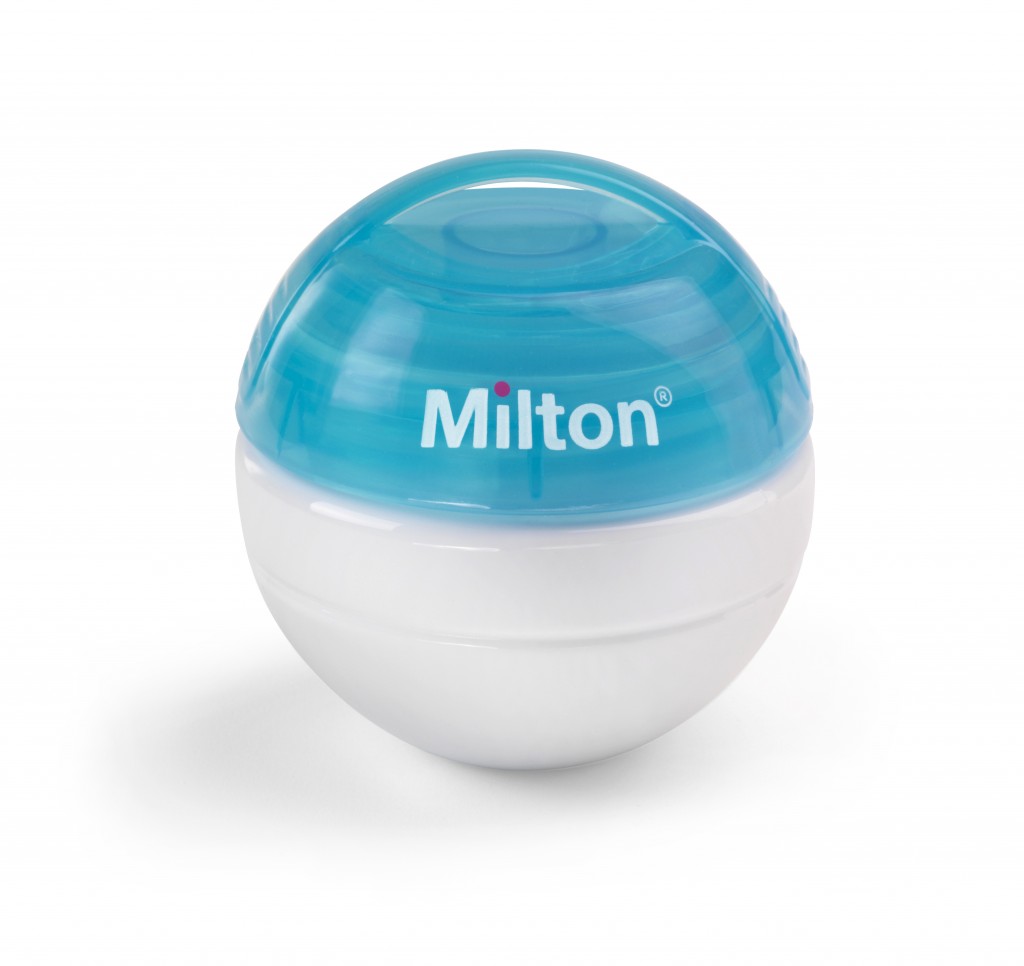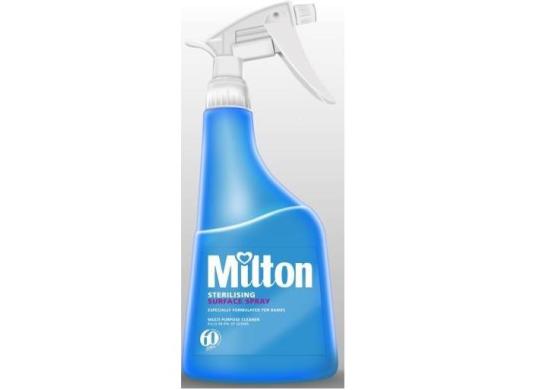Milton has launched a range to make sterilizing so much easier.
Milton Combi Microwave or Cold Water Steriliser
• Gives mum flexibility to switch between 2 popular methods of sterilisation.
• Unique, patented safety vent technology – automatic pop up vents allows safe pressure build-up in the microwave.
• stays sterile for 24 hours if left unopened
• Unique twist & lock lid – 100% spill free thus no risk of spillages in the kitchen
• Strong carry handle so it’s portable and easy to move around the kitchen
• Uni-directional design – can fit into all microwaves
• Adaptable to fit all bottle types – 5 wide neck bottles (240ml).
• Bright, modern design
• Free accessories – supplied with free tongs and Milton Sterilising Tablets 28’s
• RRSP R378,99
Mini Soother Steriliser
• Unique method to safely sterilise soothers in and out of home)
• Unique twist and lock lid – 100% watertight, no risk of spills and perfect to pop in your change bag
• Innovative sponge – helps remove dirt from baby’s soothers and absorb the solution to avoid spills
• Integral carry strap – clips easily to handbags, pushchairs, prams, change bags etc…
• Use with Milton Mini-Tablets 50’s – fill with water, add one Mini Tablet and after 15 minutes the soother is sterile. Renew every 24 hours
• Small and portable – easy to use anywhere
• RRSP R104.49
Milton Mini Sterilising Tablets 50’S
• Complementary new product, specifically developed for use with the Milton Soother Steriliser
• Available in packs of 50 tablets
• Easy to use:
– Remove sponges and fill Mini with cold water to fill level
– Add one Mini-Tablet
– Replace the sponges
– Add soother
– Wait for 15 minutes
– Ready to use
• RRSP R39.59
Milton Solo Microwave or Cold water Travel Steriliser
• Gives mum flexibility to choose 2 popular methods
• Unique, patented safety vent technology – Automatic pop up vents allows safe pressure build-up in the microwave by gently releasing excess steam. This means more heat is created in the unit which, in turn, means better sterilisation and maximum protection for babies
• Unique twist & lock lid – 100% Watertight, no risk of spillages in your kitchen.
• Unique design – Fits most size bottles on the market
• Can be positioned sideways to fit most microwaves
• For travel, overnight stays or days out – Convenient to sterilise a single bottle whenever you need it
• Sterile for longer
• RRSP R164.99
Milton Sterilising Surface Spray
• Multi- Purpose Sterilising Surface Spray especially formulated for Babies
• Convenience – no mixing & diluting with water required
• Kills 99,9% of germs
• SABS/NRCS registered & will carry SABS logo (endorsement & credibility)
• Available in 500ml trigger spray bottle size
• RRSP R32.99






28 comments
Hmmm This is so clever
Copper scrap reclamation techniques Copper scrap audits Copper scrap fabrication
Copper forgings recycling Copper scrap fabrication Scrap copper communication
Industrial copper recovery Copper scrap pricing Scrap copper granulation
Aluminium recycling economics Aluminium scrap material testing Sell aluminum scrap
Sell aluminum scrap Aluminum scrap recycling services Sustainable aluminum scrap recycling
Scrap metal collection services Ferrous scrap recycling education Iron reprocessing operations
Ferrous waste export, Iron scrap inspection services, Metal reclamation and salvage
Metal scrap yard services Aluminium construction materials scrap recycling Scrap aluminium value
Scrap metal remolding, Scrap aluminum cable pricing, Metal reclamation and recovery facility
Metal disposal facility Aluminium recycling industry trends Scrap aluminium weight measurement
Scrap metal regeneration, Aluminum cable scrap recycling process, Scrap metal services
Metal waste recycling company Ferrous material recycling appraisal Iron scrap reclaiming facility
Ferrous material tools, Iron waste repurposing center, Bronze scrap recycling
Metal reclamation and recovery solutions Scrap aluminium trading hub Scrap aluminum analysis
Metal recycling and reclamation, Aluminum cable scrap recycling services, Scrap metal reclamation and reuse
Scrap metal reclamation processes Ferrous material community impact Iron and steel scrapping
Ferrous material workforce development, Scrap iron collection, Metal repurposing facility
Industrial metal recovery Ferrous metal recycling innovations Iron reclamation and recycling
Ferrous material recycling cost optimization, Iron scrap inventory services, Metal waste processing solutions
Metal waste recovery and reuse Scrap aluminium quality standards Scrap aluminium recovery methods
Scrap metal retrieval, Aluminum cable scrap value, Scrap metal brokerage
Scrap metal recycling industry Ferrous material promotion Iron scrap processing
Ferrous metal recovery center, Iron waste reclaiming and reuse, Scrap metal management solutions
Scrap metal recovery and salvage Scrap aluminum export-import Scrap aluminium market demand
Metal scrap refurbishing services, Recycling aluminum cable scrap, Metal recycling supply
Scrap metal recovery facility Aluminium scrap green initiatives Aluminium scrap residue management
Metal scrap refurbishing services, How to recycle aluminum cables, Scrap metal reuse
Metal reclaiming and recycling solutions Ferrous material disposal solutions Iron and steel recycling plant
Ferrous material lifecycle analysis, Iron waste, Metal residue utilization
Metal reclaiming depot Aluminium scrap compaction Aluminium scrap training programs
Metal pricing services, Aluminum cable scrap environmental impact, Scrap metal reclamation plants
Copper scrap cleanliness standards Waste water treatment in copper recycling Copper scrap demand
Metal reclamation and reuse, Copper scrap export services, Metal reclamation industry
Scrap copper buyers The use of copper dates back to prehistoric times, with the earliest evidence of copper smelting dating to around 5000 BCE in the Middle East. Copper was one of the first metals to be used by humans and was easily accessible due to its widespread occurrence in nature. Copper was particularly important to ancient civilizations because of its malleability, ductility, durability, and ability to conduct electricity and heat. Early copper users used the metal primarily for ornaments and tools. Copper was used to make jewelry, decorative items, and tools such as knives, axes, and hoes. The ancient Egyptians, for example, used copper to make jewelry and decorative objects and also used it for medicine and religious rituals. In addition, copper was used to make weapons, including swords and spears. Over time, copper became more widely used for utilitarian purposes, such as for the production of coins, as well as for plumbing, roofing, and other construction uses. The ancient Romans, for example, used copper for water supply pipes and for the roofs of buildings. Copper production and consumption continued to grow throughout the ages. The Industrial Revolution saw a significant increase in copper demand, with the metal being used for machinery, electrical wiring, and transportation equipment. Copper continues to be widely used today in a variety of applications, including electronics, telecommunications, and renewable energy technologies. The mining, smelting, and refining of copper have undergone significant technological advances over the centuries, making copper more accessible and affordable. Copper extraction techniques have evolved from simple methods such as hand-picking and fire-setting to more advanced extraction processes such as froth flotation and leaching. Copper refining has also become more efficient, with advancements in electrolytic refining and solvent extraction. Despite the many advances in copper production, challenges remain, including environmental concerns related to mining and refining practices and fluctuating commodity prices. However, demand for copper continues to grow, particularly as the world moves towards a greener, more sustainable future. Copper’s unique properties make it an essential component in many renewable energy technologies, including wind turbines and solar panels. In conclusion, copper has a rich history and has played an important role in human development for thousands of years. Its versatility, durability, and conductivity have made it a valuable commodity, and technological advancements have made it accessible and affordable. As society shifts towards a more sustainable future, copper is likely to continue to play a vital role in many industries and technologies Metal reclamation plant Buy copper scrap Industrial copper disposal Copper scrap permits Scrap copper assessment Scrap metal assessment
Copper scrap branding The global economy may soon experience a great copper squeeze, as demand continues to outpace supply for the essential metal. Copper is an important component in many industries, from construction and transportation to electronics and renewable energy. As the world turns towards cleaner forms of energy and infrastructure development, copper demand is only set to rise. However, supply of copper has been facing challenges in recent years, and the COVID-19 pandemic has only exacerbated the situation. Mining operations around the world have faced disruptions due to lockdowns and restrictions, resulting in lower output. Additionally, many existing copper mines are approaching depletion, and new discoveries are becoming harder to come by. This all means that there is a growing shortfall between copper demand and supply, which could have significant economic and social impacts. Prices of copper have already been rising steadily, and some experts predict that they could double in the next few years as demand continues to rise. This could have knock-on effects in other industries, such as construction and electronics, which rely heavily on copper. One potential solution to this copper squeeze could be increased recycling and reuse of the metal. Copper is highly recyclable and can maintain its quality even after multiple uses. Encouraging more recycling and reducing waste could help ease pressure on demand for new copper supply. Overall, the coming copper squeeze highlights the need for sustainable and responsible practices in the mining and use of essential resources. With rising demand and limited supply, it is up to industries and policymakers to find innovative solutions to ensure an equitable and sustainable future for all Metal evaluation services Copper scrap import Copper tooling scrap purchase Copper recycling facility Copper alloy composition analysis Metal waste transportation
Metal waste trade Ferrous material traceability Iron and steel reclaiming services
Ferrous material sustainability reporting, Iron recuperation, Metal waste disposal yard
Economic benefits of Copper scrap recycling Copper scrap inventory forecasting Industrial scrap metal assessment
Copper cable scrap treatment, Scrap metal reclaiming and reprocessing, Copper scrap dealer network
Scrap metal reclamation facility, Industrial copper recycling capabilities, Copper cable scrap export trends, Scrap metal disposal services
Metal recycling management Metal reclamation site Iron scrap management
Ferrous material sustainability measures, Iron material recovery, Metal recovery and reprocessing center
Metal scrap reclamation facilities Ferrous metal recycling company Iron waste reclamation center
Ferrous material recycling awareness campaigns, Scrap iron recycling center, Scrap metal value recovery
Scrap metal reclamation handling Ferrous material resource optimization Iron and steel scrapping and recuperation
Ferrous metal scrap export, Iron and steel recovery, Metal waste exchange
Scrap metal safety protocols Ferrous material recycling solutions provider Scrap iron recovery facility
Ferrous material recycling plant, Iron reclamation and repurposing, Metal reclaiming and repurposing services